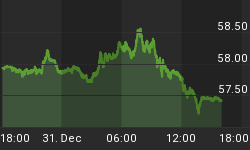Gold is once again above $1,700 and eyeing its all-time high. Yet, the same two camps are saying the same things they have since the yellow metal was at $600: either this is a bubble, or it's headed much higher. While the gold bulls have clearly been right for over ten years, that doesn't mean they will always be right. There are many ways to determine whether gold will continue its historic climb. In the past, I have looked at gold fundamentals - such as monetary inflation, increasing government deficits, and an unsustainable debt - all which indicate a bullish future. Today, I am examining a technical bellwether which has been used for decades to analyze the relative performance of stocks vs. gold.
The S&P 500-to-gold ratio measures the value of the stock market relative to gold. When the ratio is high, stocks are considered expensive relative to gold, and vice versa. This is used as an "adjustment factor" that isolates stock market performance from the effects of monetary expansion. In other words, if the S&P 500 were rising in nominal terms but the ratio to gold were falling, investors holding the S&P 500 would be losing wealth in real terms.
As you can see in the chart below, between 1980 and 2000, the S&P 500-to-gold ratio rose from 0.17 (stocks cheap) to 5.46 (stocks expensive). This rise in stocks vs. gold was led by an American business renaissance and real wealth creation, fueled by deregulation, technological progress, and globalization. Unfortunately, the US government chose to squander this progress with massive printing, borrowing, and bailouts.

Data sources: Plan B Economics, Measuring Worth,
World Gold Council, and Robert Shiller
By 2000, Washington's bad habits finally caught up to the private sector and the S&P 500 tipped into a colossal decline relative to the price of gold. This period, which is still unfolding, is marked by eroding real wealth, systemic financial stress, and inflationary pressures. Since 2000, stocks are more-or-less flat in nominal terms, but this falling ratio implies that the real value of the S&P 500 has plummeted. During this period, investors who owned gold saw their purchasing power rise relative to those who held stocks.
By looking at the historical range for the S&P 500-to-gold ratio, one can infer the extent to which a gold bull market can run. The question I often get is, "Gold has rallied for over a decade - how high can it go?" While there isn't a 'correct' S&P 500-to-gold ratio, historical bounds provide a useful guideline:
- The current S&P 500-to-gold ratio is about 0.778. To hit the ratio's post-war low of 0.17, witnessed in the summer of 1980, the S&P 500 would either have to fall by about 78% or gold would have to rise to approximately $7,850/oz (or some combination of the two).
- Looking back at the entire history of the S&P 500 and its predecessor indices (see chart below), the ratio was as low as 0.156 in 1878 and was consistently under 0.5 for half a century. To reach the 1878 low, the S&P 500 would either need to fall by over 80% or gold would need to rise to roughly $8,800/oz (or some combination of the two).

Data sources: Plan B Economics, Measuring Worth,
World Gold Council, and Robert Shiller
The S&P 500-to-gold ratio is just one of many ways to evaluate the gold bull market. While I can't predict the future prices of the S&P 500 or gold, this short historical analysis illustrates that today's ratio is not even close to treading on new territory. Until the gold fundamentals change, I believe that the yellow metal will continue to outperform stocks.
This article first appeared in the March 2012 edition of Peter Schiff's Gold Report, a monthly newsletter featuring original contributions from Peter Schiff, Casey Research, and other leading experts in the gold market.Click here for your free subscription.
Follow him on Twitter for free eBooks, documentaries and more: @planbeconomics
















